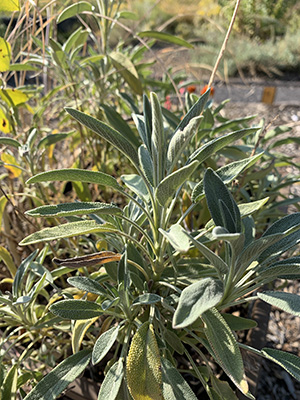October 10, 2020
Herb Appeal
with Sage Advice from Mora County Extension Agent Suzanne Cole
Our most recent NMSU gardening webinar for the “Ready, Set, GROW!” series was on herb gardening in New Mexico. Extension Agents Suzanne Cole of Mora County and John Garlisch of Bernalillo County gave informative presentations that covered distinctions between herbaceous versus woody herbs, growing them both indoors and out, and tips on how to preserve and use them in your kitchen. We received great questions from several of the over 80 attendees. For this week’s column, I’ve selected just a few of the questions and answers that I found interesting.
Question:
I have heavy clay in my garden, and amending the soil doesn't seem to help. What can you recommend?
Answer:
Poor drainage is a problem for lots of plants, and herbs are no exception. Clay soils can hold moisture for too long and prevent oxygen from reaching the roots. Luckily, many herbs grow very well with potting soil in containers or raised beds. Be sure to check that pots have drainage holes and that water flows freely from the bottom. On a related note—and contrary to popular belief—gravel does not improve drainage for potted plants or plants in the landscape. In fact, a gravel bottom layer hinders water movement, so the finer-textured soil on top actually holds moisture longer, causing it to stagnate, thereby creating a perfect environment for root rot and fungus gnats.

Question:
How should I fertilize basil growing in a pot in the kitchen?
Answer:
No fertilizer is recommended, just water, sunlight, and good drainage.
Question:
What tips can you provide for growing herbs from seed? Either they don’t germinate or, if they do, they get to be a few inches tall and then wither away.
Answer:
Using a heat mat may really help your seed starting success rate. Typical downfalls are too much water, letting seedlings dry out, and not enough light after germination. As part of our Ready, Set, GROW! gardening series, we are having a webinar on seed starting in February, and the one on saving seeds is coming up on October 21. Also see NMSU Extension Guide H-112: Seed Propagation of Plants.
Question:
What is the recommended ratio of butter to herbs for making herb butter?
Answer:
It depends partly on your personal preference and also on the herbs being used. In the webinar, Suzanne Cole described a béarnaise butter her mother used to make using tarragon and other herbs from her garden. Tarragon doesn’t have an overwhelming flavor, so you’ll need to use more of it than you would when making basil or oregano butter. It’s easy to make herb butter. First, let the butter soften. Then mix in your herbs either as whole leaves or as chopped pieces. Finally, refrigerate the butter again to harden it before serving.

Question:
Do you have suggestions for making herb salts?
Answer:
Herb salts can be made by mixing either fresh or dried herbs with salt, preferably a coarse salt. A friend’s mom, Connie Halverson, makes all sorts of fancy salts with fresh herbs from her garden, so I called her up. Halverson’s tried and true method involves collecting about a cup of fresh, clean herbs, removing leaves from stems (especially in the case of woodier plants, like rosemary), then chopping them up on a cutting board with a tablespoon of coarse salt to start. While you can try using dried herbs, Halverson emphasized that the salt penetrates the fresh leaves as you chop, adding more flavor. Spread the mixture on a tray or pan and let it air dry for 2-3 days. Once it’s all dry, use a blender to make the mixture as fine as you like, but the finer it is, the more likely it will cake up over time. Add up to four tablespoons of salt to taste through the chopping, drying, and blending steps. Halverson suggests trying all kinds of herbs and particularly recommends a Tuscan mix of salt with sage, rosemary, thyme, and garlic. Or try Thai basil and dill. Another tip is to use fresh green or red chile and follow the same method as though it’s an herb! Visit the Desert Blooms blog version of this column for more inspired herb salt ideas. I’m going to sprinkle mine on popcorn.
The best advice I’ve heard for maintaining a healthy herb garden is to harvest as though you’re going to use the cuttings, even if they’re going directly into the compost pile. This way the plants don’t get too leggy and scraggly looking, plus the new growth tends to be more tender and palatable. Sure enough, in my own patio containers this summer, I harvested catnip from one side of the plant every few weeks to share with friends who have kitties. By mid-July, I noticed that the side I hadn’t trimmed was looking tired already, with tattered older leaves, while the side I had harvested from looked fresher and more manicured with lots of new branches and developing leaves. Regular pruning (or “herb cuts” as I like to call them) can also keep plants like basil and dill from going to seed too early (aka bolting). For more tips on herb gardening in New Mexico, check out NMSU Extension Guide H-221: Spices and Herbs for the Home Garden, and a helpful YouTube video from the Southwest Yard & Garden show How To Grow An Herb Garden video.

Marisa Y. Thompson, PhD, is the Extension Horticulture Specialist, in the Department of Extension Plant Sciences at the New Mexico State University Los Lunas Agricultural Science Center, email: desertblooms@nmsu.edu, office: 505-865-7340, ext. 113.
Links:
For more gardening information, visit the NMSU Extension Horticulture page at Desert Blooms and the NMSU Horticulture Publications page.
Send gardening questions to Southwest Yard and Garden - Attn: Dr. Marisa Thompson at desertblooms@nmsu.edu, or at the Desert Blooms Facebook page.
Please copy your County Extension Agent and indicate your county of residence when you submit your question!